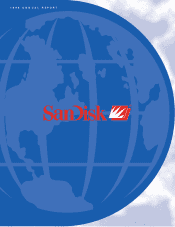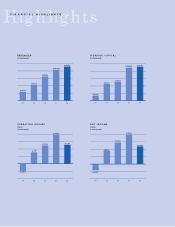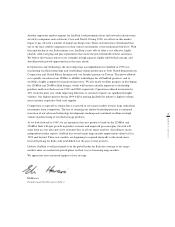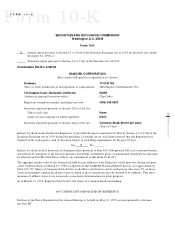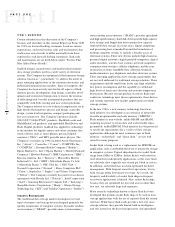SanDisk 1998 Annual Report Download - page 11
Download and view the complete annual report
Please find page 11 of the 1998 SanDisk annual report below. You can navigate through the pages in the report by either clicking on the pages listed below, or by using the keyword search tool below to find specific information within the annual report.
SanDisk Corporation
6
ITEM 1. BUSINESS
Certain statements in this discussion of the Company’s
business and elsewhere in this Annual Report on Form 10-K
for 1998 are forward looking statements based on current
expectations, and entail various risks and uncertainties that
could cause actual results to differ materially from those
expressed in such forward looking statements. Such risks
and uncertainties are set forth below under “Factors That
May Affect Future Results”.
SanDisk designs, manufactures and markets flash memory
data storage products used in a wide variety of electronic
systems. The Company has optimized its flash memory storage
solution, known as “system flash,” to address the needs of
many emerging applications in the consumer electronics and
industrial/communications markets. Since its inception, the
Company has been actively involved in all aspects of flash
memory process development, chip design, controller devel-
opment and system-level integration to ensure the creation
of fully-integrated, broadly interoperable products that are
compatible with both existing and new system platforms.
The Company believes its core technical competencies are in
high-density flash memory process and design, controller
design, system-level integration, compact packaging and
low-cost system test. The Company’s products include
removable CompactFlash™products, FlashDisk cards and
MultiMediaCard products, and embedded FlashDrives and
Flash ChipSet products. SanDisk has applied its technology
to the markets for digital cameras and other consumer elec-
tronics devices such as smart phones, personal digital
assistants (“PDA”) and MP3 portable music players. The
Company’s customers in 1998 included Arrow Electronics,
Inc. (“Arrow”), Canon Inc. (“Canon”), COMPUSA, Inc.
(“COMPUSA”), Eastman Kodak Company (“Kodak”),
Epson Hanbai Co., Ltd. (“Epson Hanbai”), Hewlett-Packard
Company (“Hewlett-Packard”), IBM Corporation (“IBM”),
Kyocera America, Inc. (“Kyocera”), Matsushita Electric
Industrial Co., Ltd. (“MEI”), Mitsubishi Plastic Co. Ltd.
(“Mitsubishi Plastic”), NEC USA Inc. (“NEC USA”),
Norand Corporation (“Norand”), Psion Computers PLC
(“Psion”), Staples Inc. (“Staples”) and Telxon Corporation
(“Telxon”). The Company currently has patent cross-license
agreements with Hitachi Ltd. (“Hitachi”), Intel Corporation
(“Intel”), Samsung Electronics Company Ltd. (“Samsung”),
Sharp Electronics Corporation (“Sharp”), Silicon Storage
Technology, Inc. (“SST”) and Toshiba Corporation (“Toshiba”).
Industry Background
The traditional data storage market encompasses several
types of memory and storage devices designed primarily for
specific components of computer systems. Dynamic random
access memory (“DRAM”) provides main system memory;
static random access memory (“SRAM”) provides specialized
and high speed memory; hard disk drives provide high capacity
data storage; and floppy disk drives permit low capacity
removable data storage. In recent years, digital computing
and processing have expanded beyond the boundaries of
desktop computer systems to include a broader array of
electronic systems. These new devices include digital cameras,
personal digital assistants, highly portable computers, digital
audio recorders, wireless base stations, network computers,
communication switches, cellular telephones, mobile com-
munication systems, handheld data collection terminals,
medical monitors, pay telephones and other electronic systems.
These emerging applications have storage requirements that
are not well addressed by traditional storage solutions. These
requirements include small form factor size, high reliability,
low power consumption and the capability to withstand
high levels of shock and vibration and extreme temperature
fluctuations. Because storage products based on flash semi-
conductor technology meet those requirements, these devices
and systems represent new market opportunities for flash
storage systems.
In the late 1980s, a new memory technology, known as
flash memory, was developed as an extension of ultraviolet
erasable programmable read-only memory (“EPROM”).
Flash memory is non-volatile, unlike DRAM and SRAM,
requiring no power to retain data and is electrically repro-
grammable, unlike EPROM. Flash memory has the potential
to satisfy the requirements for a variety of data storage
applications although the most common types of flash
memory, “socket flash” and “linear flash,” are not well
suited for many purposes.
Socket flash is being used as a replacement for EPROMs in
applications such as embedded firmware or microcode storage
in computer systems. Typical chip densities for socket flash
range from 1Mbit to 32Mbit. Socket flash is well suited for
read often/write infrequently applications, as the erase times
are relatively slow (typically one second per block or sector).
In addition, socket flash has not been optimized for defect
management. With frequent erase/write operations, bits in
flash storage media deteriorate over time. As a result, the
longevity and durability of socket flash chips in frequent
erase/write applications is limited. Also, socket flash chips,
because they are optimized for fast read access rather than
low cost, are relatively large and expensive.
More recently, technology known as linear flash has been
developed that permits socket flash chips to be used in data
storage applications with the use of separate flash file system
software. While linear flash cards provide a low-cost mass
storage solution, they provide limited built-in intelligence,
and rely instead on the host microprocessor and specialized
Part I
PA RT ON E

